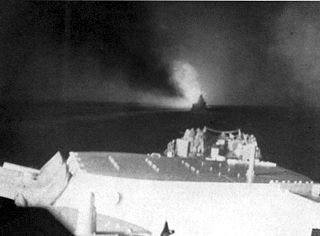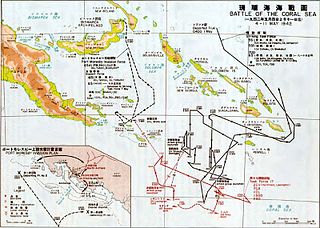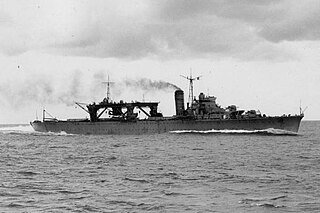
A cruiser is a type of warship. Modern cruisers are generally the largest ships in a fleet after aircraft carriers and amphibious assault ships, and can usually perform several operational roles from search-and-destroy to ocean escort to sea denial.

The Battle of Empress Augusta Bay, on 1–2 November 1943 – also known as the Battle of Gazelle Bay, Operation Cherry Blossom, and in Japanese sources as the Sea Battle off Bougainville Island (ブーゲンビル島沖海戦) – was a naval battle fought at night in Empress Augusta Bay near Bougainville Island. The naval battle was a result of Allied landings at Cape Torokina with the bay in the first action in the Bougainville campaign of World War II and may also be considered as part of the Solomons and New Guinea campaigns. The battle was significant as part of a broader Allied strategy—known as Operation Cartwheel—aimed at isolating and surrounding the major Japanese base at Rabaul. The intention was to establish a beachhead on Bougainville, within which an airfield would be built.

The Battle of Kolombangara was a naval battle of the Pacific campaign of World War II, fought on the night of 12/13 July 1943, off the northeastern coast of Kolombangara in the Solomon Islands. The battle took place during the early stages of the New Georgia campaign when an Imperial Japanese Navy force, carrying reinforcements south to Vila, Solomon Islands, was intercepted by a task force of U.S. and New Zealand light cruisers and destroyers. In the ensuing action, the Japanese sank one Allied destroyer and damaged three cruisers. They were also able to successfully land 1,200 ground troops on the western coast of Kolombangara but lost one light cruiser sunk in the process.

USS Montpelier (CL-57) was one of 27 United States Navy Cleveland-class light cruisers completed during or shortly after World War II. She was the second US Navy ship to be named for the city of Montpelier, Vermont. Montpelier was commissioned in September 1942 and saw service in several campaigns in the Pacific. Like almost all her sister ships, she was decommissioned shortly after the end of the war, and never saw active service again. Montpelier was scrapped in the early 1960s.

USS Denver (CL-58) was a Cleveland-class light cruiser. Denver launched on 4 April 1942 by New York Shipbuilding Corp., Camden, New Jersey; sponsored by Miss L. J. Stapleton, daughter of the Mayor of Denver; and commissioned on 15 October 1942, Captain Robert Carney in command. It was the second ship named for the city of Denver, Colorado.

The Battle of Cape Esperance, also known as the Second Battle of Savo Island and in Japanese sources as the Sea Battle of Savo Island (サボ島沖海戦), took place on 11–12 October 1942, in the Pacific campaign of World War II between the Imperial Japanese Navy and United States Navy. The naval battle was the second of four major surface engagements during the Guadalcanal campaign and took place at the entrance to the strait between Savo Island and Guadalcanal in the Solomon Islands. Cape Esperance (9°15′S159°42′E) is the northernmost point on Guadalcanal, and the battle took its name from this point.

The Battle of Blackett Strait was a naval battle of the Pacific campaign of World War II, fought on 6 March 1943 in the Blackett Strait, between Kolombangara and Arundel Island in the Solomon Islands. The battle was a chance encounter between two Japanese destroyers that had been undertaking a resupply run to Vila and a U.S. Navy force of three light cruisers and three destroyers that had been tasked with bombarding the Japanese shore facilities around Vila. The two forces clashed as the Japanese destroyers were withdrawing through the Kula Gulf. In the short battle that followed the two Japanese destroyers were sunk, after which the U.S. ships completed their bombardment of Vila before returning to their base.

Tenryū was the lead ship in the two-ship Tenryū class of light cruisers of the Imperial Japanese Navy. Tenryū was named after the Tenryū River in Nagano and Shizuoka prefectures.
The Shortland Islands is an archipelago of Western Province, Solomon Islands, at 6.92°S 155.88°E. The island group lies in the extreme north-west of the country's territory, close to the south-east edge of Bougainville Island, Papua New Guinea.
Murasame was the third of ten Shiratsuyu-class destroyers, and was built for the Imperial Japanese Navy under the "Circle One" Program. This vessel should not be confused with the earlier Russo-Japanese War-period Harusame-class torpedo boat destroyer with the same name.

Kinugasa (衣笠) was the second vessel in the two-vessel Aoba class of heavy cruisers in the Imperial Japanese Navy. The ship was named after Mount Kinugasa, located in Yokosuka, Kanagawa, Japan.

Kako (加古) was the second vessel in the two-vessel Furutaka class of heavy cruisers in the Imperial Japanese Navy. The ship was named after the Kako River in Hyogo prefecture, Japan.

Operation Mo or the Port Moresby Operation was a Japanese plan to take control of the Australian Territory of New Guinea during World War II as well as other locations in the South Pacific. The goal was to isolate Australia and New Zealand from the Allied United States.

Chitose (千歳) was a warship of the Imperial Japanese Navy that served from 1938 to 1944, seeing service as a seaplane carrier and later as a light aircraft carrier during World War II. In her initial guise as a seaplane carrier, she first saw service during the Second Sino-Japanese War in 1938, and subsequently played a key role in the Imperial Japanese Navy's development of a network of seaplane bases on the islands of the Pacific Ocean. After the outbreak of World War II in the Pacific, she took part in the Philippines campaign, the Dutch East Indies campaign, the Battle of Midway, and the Guadalcanal campaign, during which she was damaged in the Battle of the Eastern Solomons and also saw service related to the Battle of Cape Esperance.

The Adriatic Campaign of World War I was a naval campaign fought between the Central Powers and the Mediterranean squadrons of Great Britain, France, the Kingdom of Italy, Australia, and the United States.

Chiyoda was a light aircraft carrier of the Imperial Japanese Navy during World War II. Originally constructed as the second vessel of the Chitose-class seaplane tenders in 1934, she continued to operate in that capacity during the Second Sino-Japanese War and the early stages of the Pacific War until her conversion into a light aircraft carrier after the Battle of Midway. She was sunk during the Battle of Leyte Gulf by a combination of naval bombers, cruiser shellfire and destroyer-launched torpedoes.

The 8th Fleet was a fleet of the Imperial Japanese Navy (IJN) established during World War II.
The 5th Fleet was a fleet of the Imperial Japanese Navy, active during the early portions of the Second Sino-Japanese War, and again in World War II, primarily in the Aleutian campaign, during which it was augmented and designated the Northern Area Force.

Uzuki was one of twelve Mutsuki-class destroyers built for the Imperial Japanese Navy (IJN) during the 1920s. During the Pacific War, she participated in the Battle of Wake Island in December 1941 and the occupations of New Guinea and the Solomon Islands in early 1942.

The Australian occupation of German New Guinea was the takeover of the Pacific colony of German New Guinea in September – November 1914 by an expeditionary force from Australia, called the Australian Naval and Military Expeditionary Force.

















